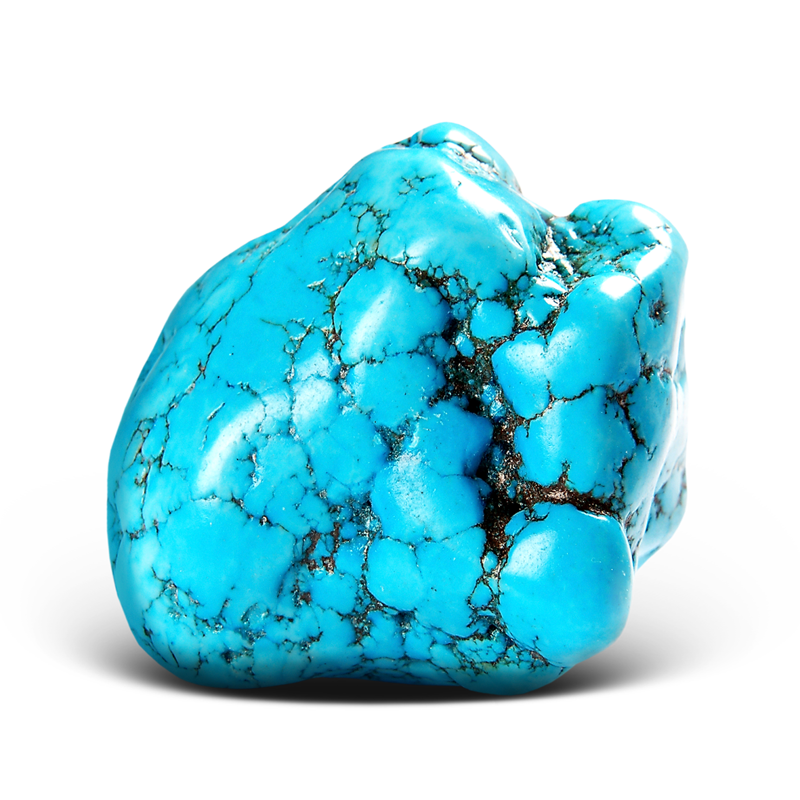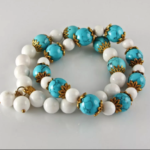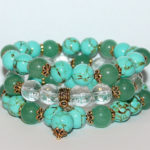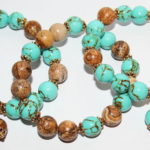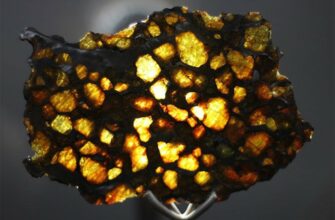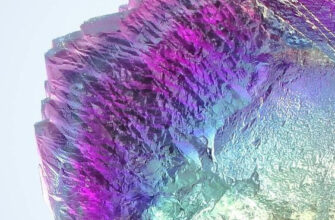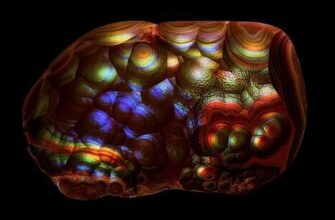The semi-precious stone turquoise, which is a symbol of fidelity and love, as well as a talisman against misfortunes and evil spirits, has been known to mankind since time immemorial. Repeatedly sung in myths and legends, it has many healing and magical properties. Lithotherapists use it to treat diseases, and jewelers use it to create amazing jewelry.
What is this stone - description
The name "turquoise", derived from the Persian word "firuze", means "stone of happiness" (another meaning of this word is "victorious").
The gem, formed in the thickness of sedimentary rocks as a result of hydrothermal processes, occurs in nature in the form of dense cryptocrystalline masses, crusts, veins, rounded small inclusions and tuberculate, rounded cluster-shaped concretions.
Their surface is dotted with small inclusions and a network of branching brown or black veins. The structure of each individual pebble is an agglomerate, not a crystal.
Gemologists classify translucent specimens of bright blue color as precious gems (they make up 10% of all turquoise mined), all other specimens (90% of them) are semiprecious.
History of use
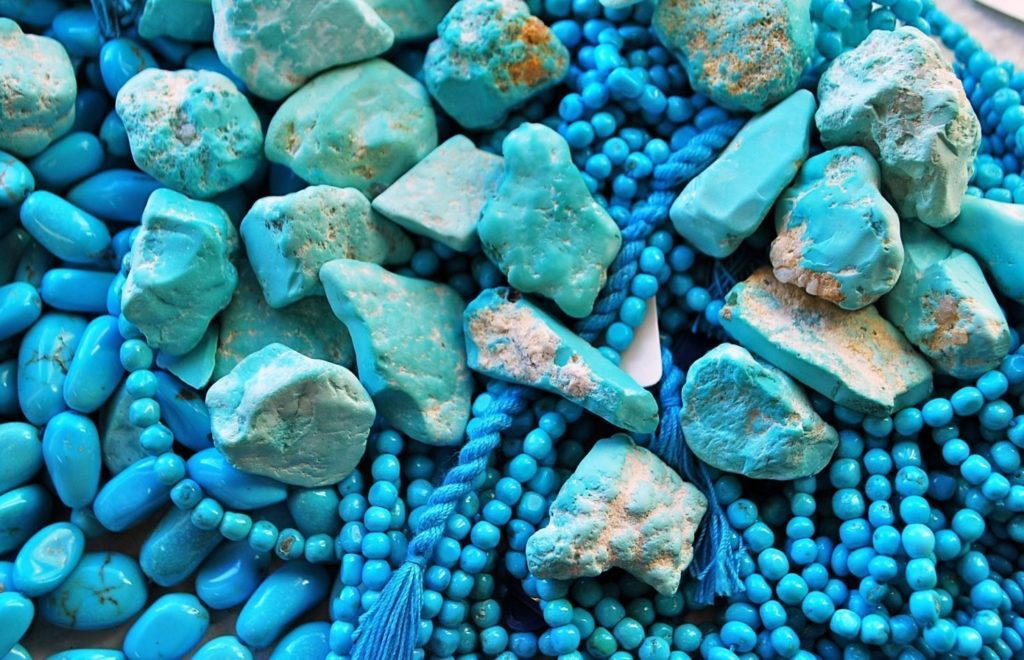
- According to archaeological excavations, produced in Central Asia, China, Egypt, America and India, turquoise was extremely popular in ancient cultures.
- On the Sinai Peninsula the first sky-blue pebbles were discovered 7 thousand years ago.
- Mayan and Aztec tribes they decorated human skulls with turquoise, made masks, mosaic panels and sacrificial knife handles from it. The "Stone of Heaven" was often used as a means of payment or exchanged for cocoa beans or feathers of tropical birds.
- In ancient egypt turquoise was most commonly used to make figurines of scarab beetles. Jewelry, charms and amulets with turquoise were found in the tombs of Tutankhamen and Nefertiti. The age of a gold bracelet with turquoise, found on one of the Egyptian mummies, according to archaeologists, is 8 years.
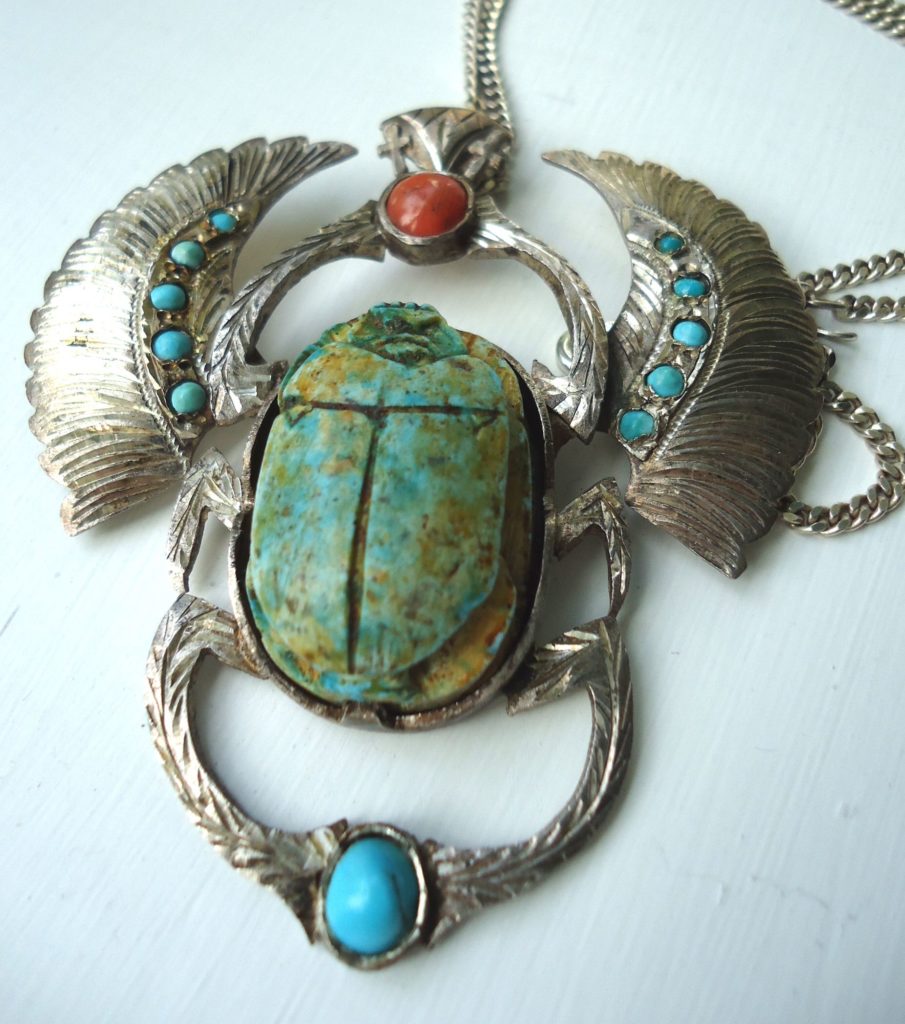
- Turkish Janissaries, trying to make themselves invulnerable, kept amulets and amulets with turquoise, and horses were put on a harness decorated with this gem.
- Boris Godunov, sitting on a throne decorated with light turquoise (it was a gift from the Iranian Shah), he acquired equanimity and calmness.
- According to legend, Ivan the Terrible, noticing that the turquoise darkens in his hands, saw in this a sign of the approaching death.
- Marie Louise of Austria - the beloved of Napoleon Bonaparte and the future Empress of France - in 1810 she received a wedding gift from him: a magnificent tiara with diamonds and turquoise (the emeralds that adorned it initially were replaced by turquoise by order of the emperor).
- One of the Muslim shrines is a turquoise stone engraved with a legend that tells about the life, miracles and teachings of Mohammed, the founder of Islam.
- Inhabitants of Tibet they see in turquoise not a stone, but a divine essence; to them it is sacred.
Today, turquoise jewelry and amulets are given in honor of the 18th wedding anniversary.
The value of the stone
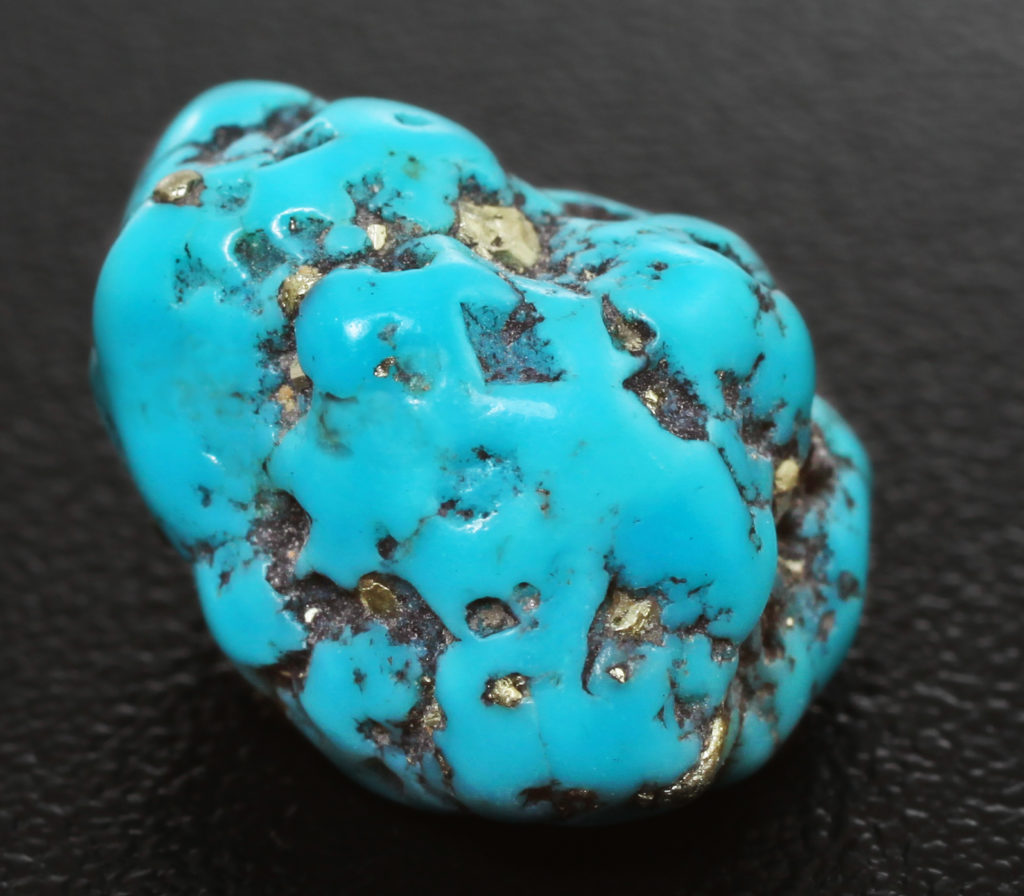
The main meaning of turquoise is its use as a jewelry or ornamental stone.
Since the cutting of a fragile gem is associated with certain difficulties, most often it is cut cabochon and used as an insert for brooches, earrings and rings.
Beads, pendants or bracelets are often made up of free-form pebbles, subjected to only minimal polishing.
For Muslims, jewelry with turquoise, which is considered a symbol of purity and a guarantee of a happy family life, is an indispensable element of the bride's wedding attire.
Physical properties of turquoise

Turquoise, which is a hydrated aluminum and copper phosphate, is characterized by:
- Increased brittleness (its hardness on the Mohs scale is 5-6 points).
- Weak pleochroism.
- Bluish or whitish luminescence, characteristic of only some specimens. Most of the samples are missing.
- Lines in white.
- Lack of dispersion.
- Dull waxy sheen.
- Irregular conchoidal fracture.
- Porous structure and density equal to 2,6-2,8 g/cm3.
- triclinic syngony.
- Perfect cleavage.
- The ability to crack and turn brown when heated (unlike fakes), and also dissolve in hydrochloric acid.
- Complete opacity (only the most expensive and very rare specimens are translucent).
- A rich spectrum of shades of blue and green. Some copies are painted white. On the surface of most samples there are brown spots and many thin dark stripes.
| Property | Description |
|---|---|
| Formula | CuAl6(OH)2[PO4]·4H2O |
| Hardness | 5 – 6 Feet |
| Density | 2,6-2,8 g / cm³ |
| Refractive index | 1,61-1,65 |
| Kink | Rough and uneven. |
| Cleavage | Perfect, imperfect. |
| Transparency | Opaque. |
| Syngonia | Triclinic. |
| Color | Green, often with brown spots, blue, light blue, blue-green. |
Turquoise deposits
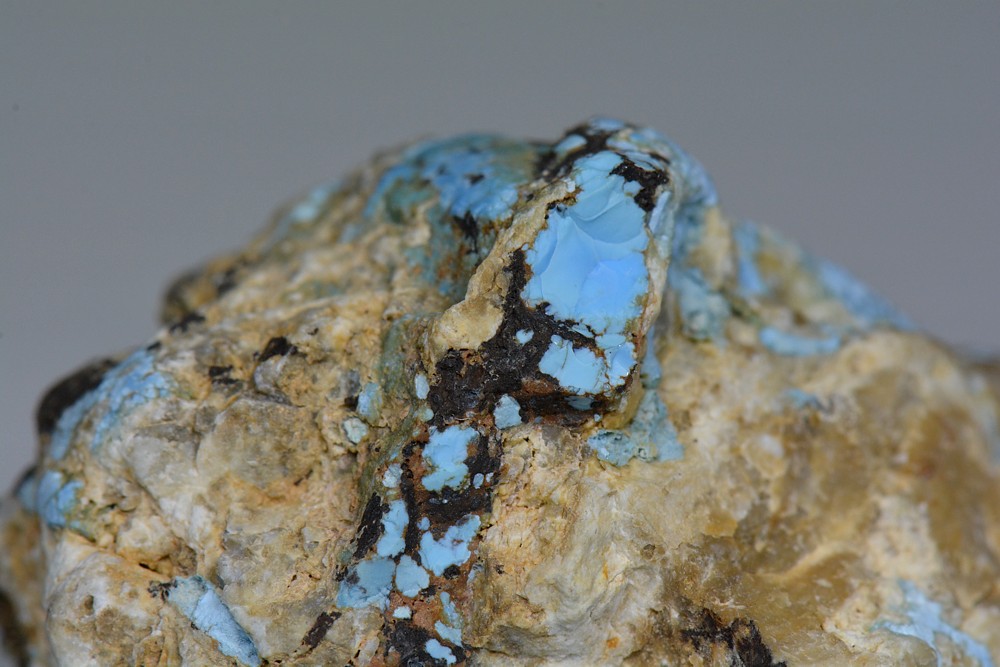
Despite the numerous deposits, the reserves of turquoise, which is one of the most sought-after ornamental stones mined for several millennia (some ancient mines are still operating), are not too large.
That is why the extraction of a natural gem requires large material costs.
Today, most natural turquoise comes from large copper mines as a by-product of copper mining.
The most famous stone deposits are on the territory:
- USA;
- Egypt
- Iran;
- Argentina
- Afghanistan;
- Turkmenistan;
- Australia
- Tajikistan;
- Armenia
- Uzbekistan
- Tanzania;
- Sinai Peninsula.
The best in the world is sky-blue turquoise, mined in the vicinity of the city of Nishapur (Iran).
Since the extraction of Persian turquoise is carried out only by hand, it is much more expensive than gems coming from other countries.
The volume of production of Iranian turquoise (compared to the 70s of the last century) has decreased 10 times.
Varieties, colors
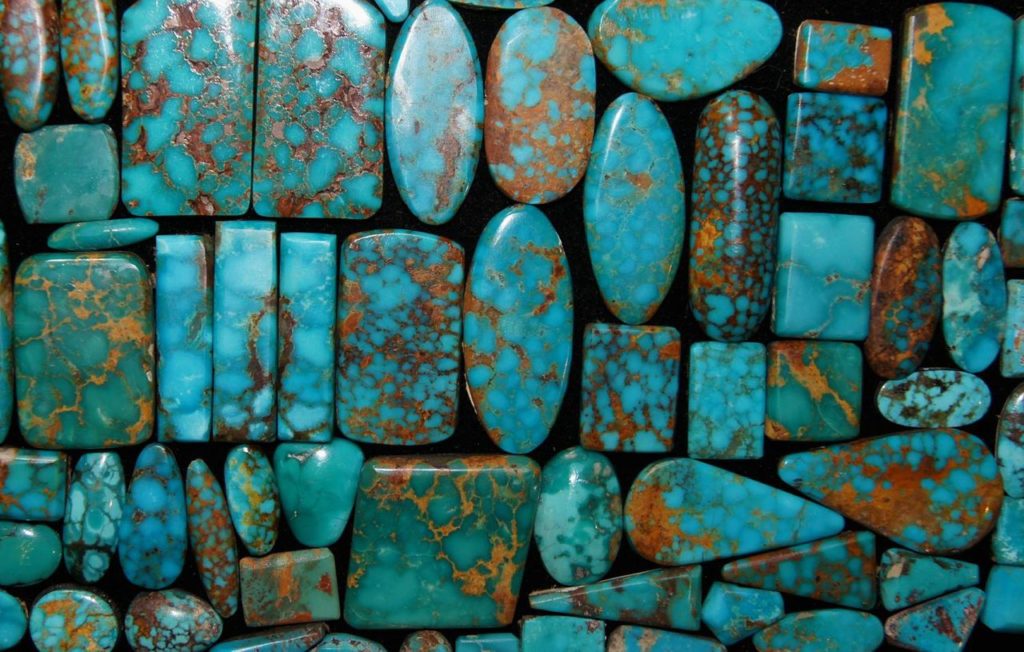
The main characteristics that allow mineralogists to distinguish turquoise are its age and color:
- young stones painted in white or light blue tones. This variety is porous and looks like a bone. It is rarely used in jewelry, but is very much in demand among collectors.
- mature gems have a bright blue or turquoise color, due to the predominance of copper and the virtual absence of iron in their chemical composition. This is the most expensive and popular type of turquoise.
- old nuggets most often painted in green, green-blue, brown and gray tones. Their cost in the jewelry market is low.
The color change is due to the gradual displacement of copper oxide by iron oxide. As a result, the mineral first turns green and then turns brown.
In the turquoise color palette - in addition to the above - there are the following colors:
Blue
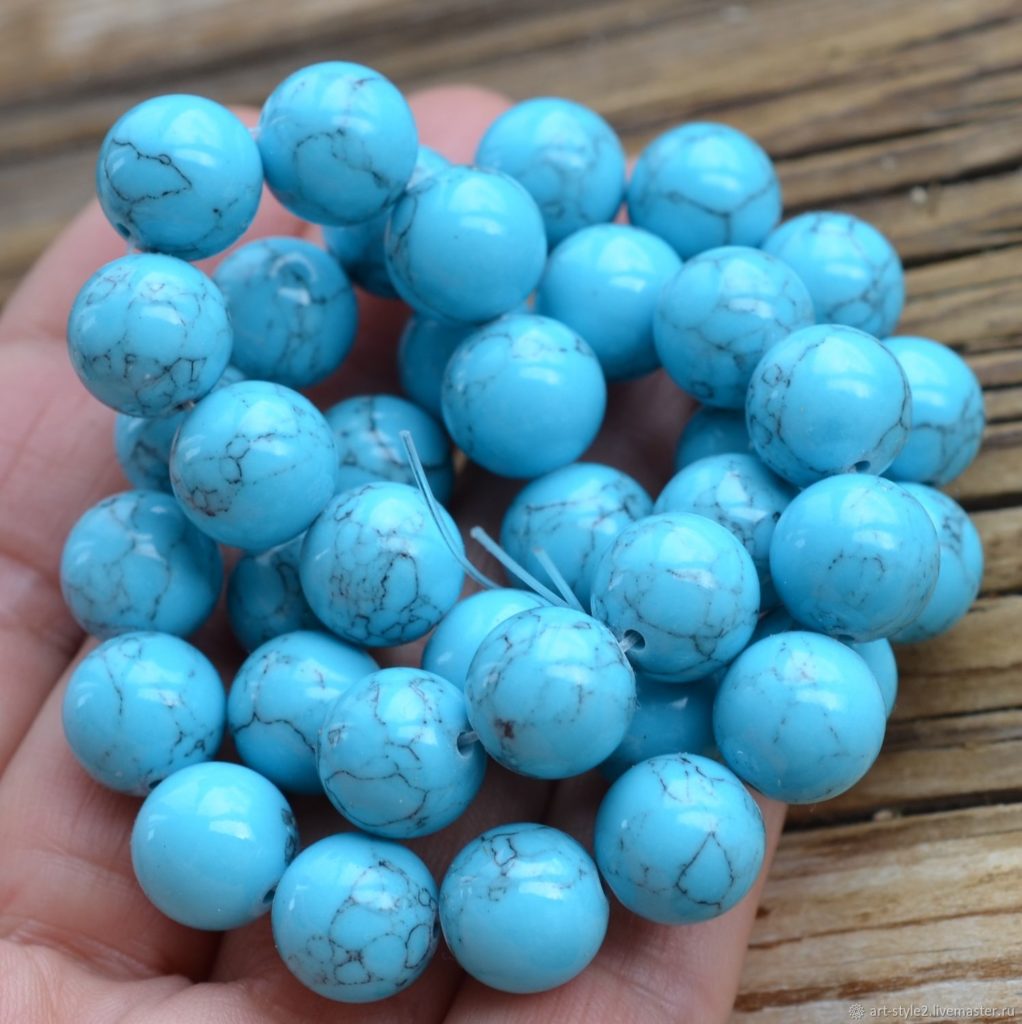
The most valuable and rare shade, popular with collectors and talisman lovers.
Red

This color - due to a large amount of copper - is acquired either by very old stones or artificially colored nuggets.
The pink color indicates that it is an imitation obtained by tinting the cheap natural mineral howlite or pale turquoise stones. It does not occur in nature.
Depending on the place of extraction, turquoise is divided into the following types:
Iranian
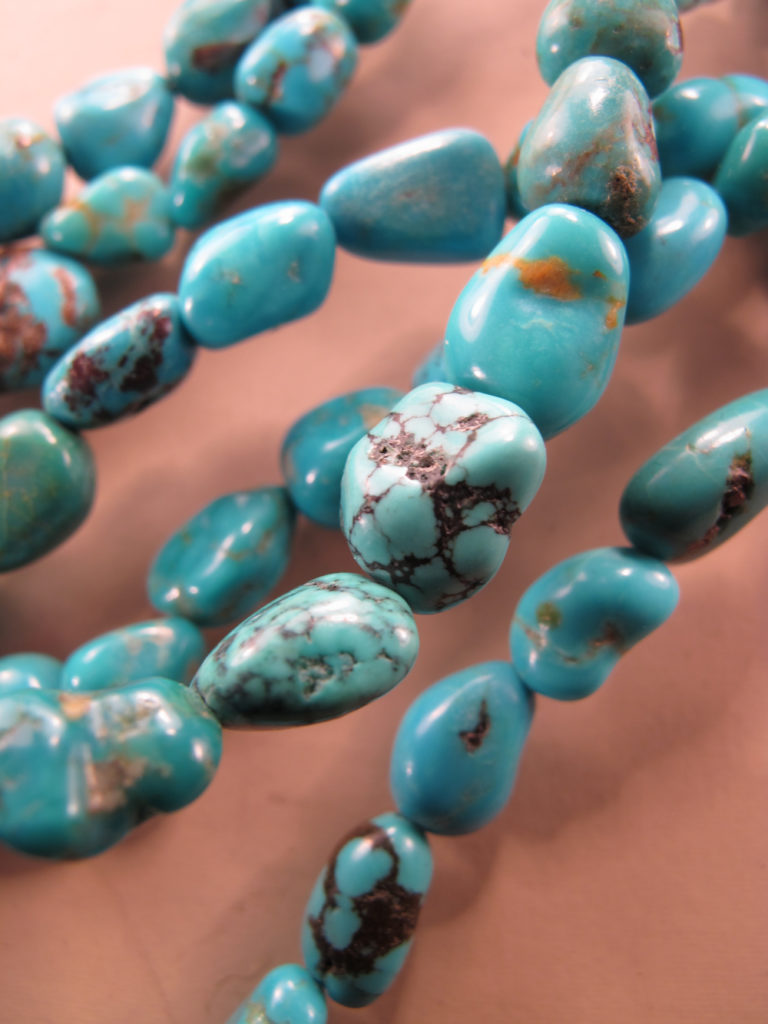
Sometimes it is called Persian - the hardest and most beautiful variety;
Arizona

This is a very expensive (over $ 500 per carat) gem that has a bright blue color;
The Israeli

A rare variety, a characteristic feature of which is a green color;
Tibetan

characterized by an amazing variety of colors (including the extremely rare gossamer turquoise, speckled with the finest veins of other rocks);
Kazakhstan

Being the youngest, this variety, valued less than all the others, is distinguished by its softness and paleness of colors.
The so-called "African" turquoise is nothing more than jasper, painted in a soft turquoise color. Being an imitation of a gem, it has nothing to do with Africa.
The magical properties of turquoise

The magical properties of turquoise help her:
- change character its owner for the better, making him more merciful and kinder.
- Reestablish harmony in the family, stop quarrels and enmity.
- fence owner from energy vampires, damage and evil eye.
- Act as an indicator, signaling diseases and the state of the human body. During illness or after the death of the owner, the stone fades. After finding a new owner, its brilliance and brightness are restored.
- promote revealing abilities and talents.
- Be a relationship marker. The changed color of the stone can signal the betrayal of one of the spouses, a quarrel or an impending separation.
- Attract to its owner love, happiness and financial well-being.
- Provide the owner of the stone has contact with the management, thanks to which he can make a good career.
The magic of the gem, however, applies only to those who, having set themselves noble goals, achieve them in an honest way.
The healing properties of turquoise stone

The healing properties of turquoise allow you to:
- Cure viral and coldsas well as respiratory diseases. To prevent their occurrence, it is recommended to wear a suspension. Beads will cope with a serious pathology.
- Cleanse the liver and blood of toxins. Bracelets and rings made of natural stones will help to achieve a positive effect.
- Normalize the functioning of the thyroid gland and thereby solve the problem of excess weight.
- Relieve patient fatigue, migraines and headaches. Turquoise earrings can accomplish this task.
- Calm the psyche and cope with insomnia (just put a pebble under the pillow).
- Accelerate wound healing, stop bleeding, get rid of scars and scars.
Who is suitable for the sign of the zodiac

("++" - the stone fits perfectly, "+" - can be worn, "-" - absolutely contraindicated):
| Zodiac sign | Compatibility |
|---|---|
| Aries | ++ |
| Taurus | ++ |
| Gemini | + |
| Cancer | + |
| a lion | — |
| Virgo | + |
| Scales | + |
| Scorpio | ++ |
| Sagittarius | ++ |
| Capricorn | + |
| Aquarius | + |
| Pisces | + |
- Horoscope claimsthat turquoise is perfect Taurus. Having revealed their hidden abilities with its help, they will be able to change their lives for the better.
- The amulet will endow Gemini self-confidence and will show the way to inner harmony.
- Cancerswho enlisted the support of the stone, will be able to arrange a personal life, reach the heights of career growth and achieve the recognition of others.
- A turquoise amulet will protect Sagittarius from spiritual wounds and will help to achieve success in any business.
- Scorpionswho are the owners of the magic talismanwill be able to solve the most difficult problems and realize the cherished hopes and dreams.
- Scalesfeeling a surge of vitality, will be able to overcome melancholy and come to terms with the feeling of the transience of time.
- With the help of a gem Aries learn to overcome their impulsiveness and feel the strength necessary to perform important things that can significantly improve their financial well-being.
- Capricornsgetting promoted, will immediately receive credit of trust from others.
Useful for all other signs of the zodiac, turquoise is contraindicated Leo, Pisces, Aquarius and Virgo. The influence of the amulet can provoke depression in them, a state of apathy and a loss of inner harmony.
Talismans and charms
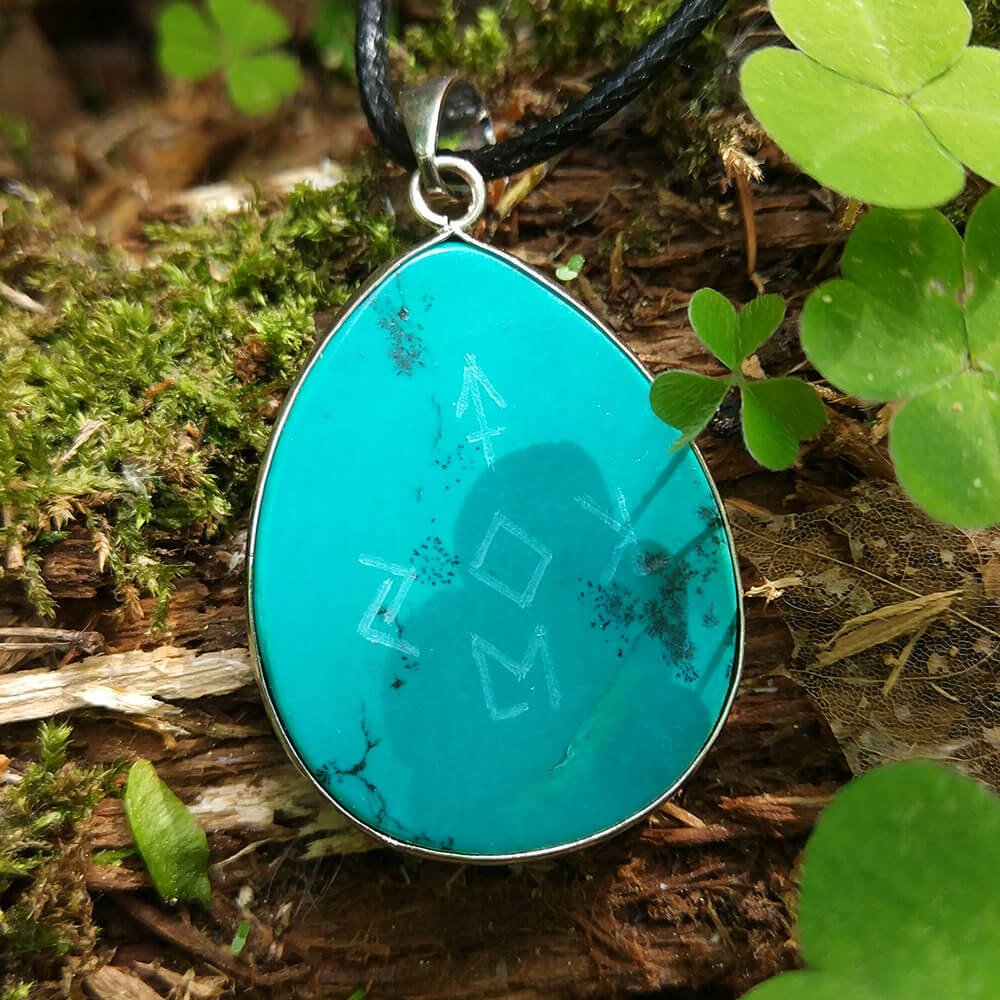
Talismans and amulets made of real turquoise are recommended to have:
- People of any age: children and old people can wear them around their necks; for everyone else, a ring or a ring will do. With their help, they will gain reliable protection from evil spirits and all sorts of troubles.
- Travelers: the stone will save them from trouble along the way.
- For pregnant women: an unprocessed gem will ensure the normal course of pregnancy and the birth of a healthy child.
- People in dangerous professions (for example, rescuers) and those who are fond of extreme sports. White turquoise will protect them from all sorts of dangers.
- To cleanse your own biofield and replenishment of vital energy.
- Lonely women. Being a stone of love, turquoise activates their sexuality, helps them meet a worthy admirer and find female happiness.
- For married men: this will keep them from cheating.
Turquoise needs regular energy cleaning and recharging. To do this, it is enough to hold it in a bright place for several hours (but not under direct sunlight).
Turquoise Jewelry
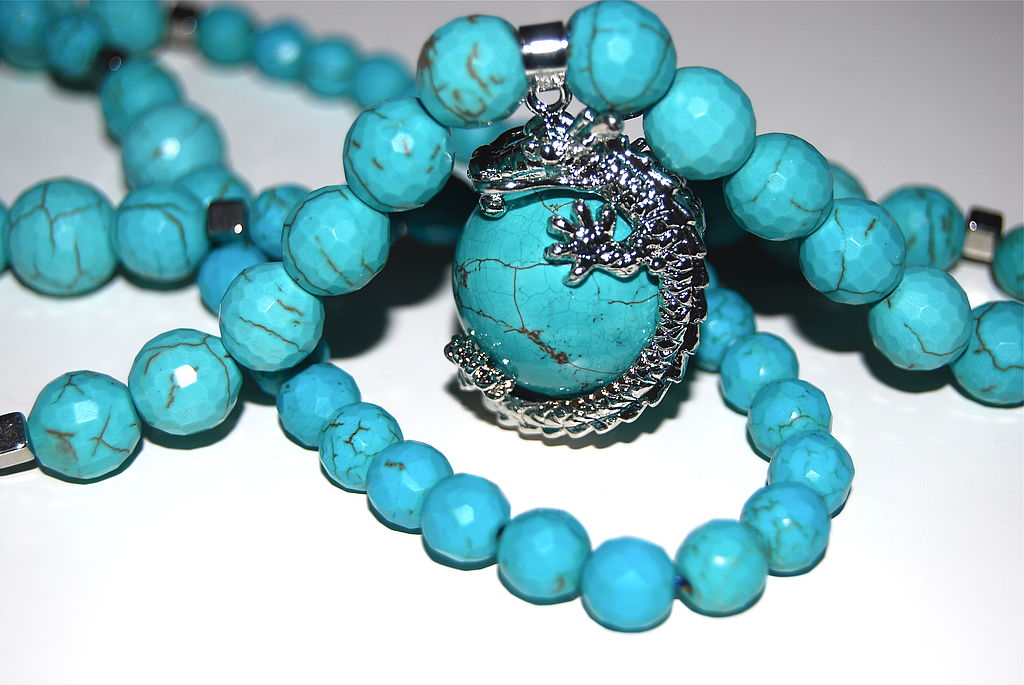
Masters of ancient times processed turquoise with wax or resin. As a result, the matte mineral became shiny and more durable.
Today's jewelers often use pressed turquoise, obtained from natural gem crumbs, since such pebbles - compared to natural gems - are more durable, bright, durable and resistant to mechanical stress.
Stones of blue tones are set in light metals (silver, platinum, white gold); green - in yellow gold.
Jewelry in which turquoise is adjacent to aquamarine, pearls, lapis lazuli, grenade and amber.
Turquoise jewelry is best combined with clothes made from natural fabrics, dyed in light colors (white, gold or beige).
Pale stones are recommended for people with blue or green eyes; owners of brown eyes can afford products with inserts of a darker and more saturated color.
Other uses of stone
Turquoise is used for:
- decorating desktop writing instruments, fountain pens, pocket or mantel clocks;
- collections;
- making small plastics (figurines of scarabs are popular);
- treatment of many diseases.
Turquoise price
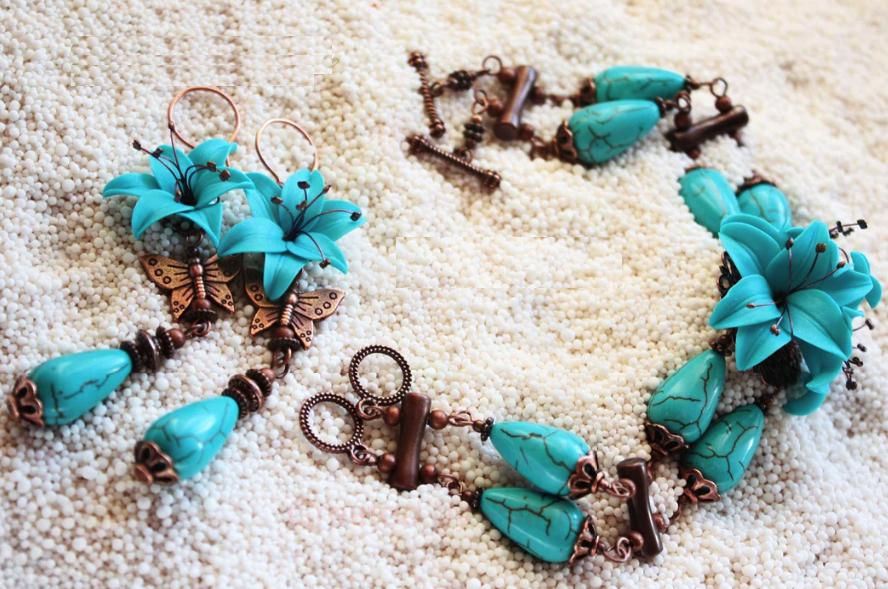
The value of turquoise depends on its purity and physical properties. The most expensive copy, which has a high density and does not have dark veins, costs at least $ 30 per carat (0.2 grams).
The presence of porosity, yellowness, veins or spotting significantly reduces the price of nuggets.
Since the deposits of natural turquoise are currently very depleted, 95% of the stones sold on the world market and presented as a natural gem are either fake or turquoise, but ennobled or strengthened.
The price mainly depends on what metal the product is made of. Manufacturers offer turquoise jewelry, you can buy such products at about the following cost:
- the price of a natural stone pendant without a frame is $20–30;
- a turquoise crumb bracelet costs $25;
- prices for gem beads $80;
- an exquisite silver ring with natural turquoise will cost around $90.
The presented prices indicate that many who wish to purchase such a product can afford it. At a low cost per product, it is possible to use imitation, you should be careful in choosing.
Fake diamond

An artificial stone obtained in the laboratory using nanotechnology and outwardly similar to natural turquoise is its complete analogue.
The technique developed by Russian specialists makes it possible to obtain stones whose chemical and physical properties are identical to those of natural gems.
The only drawback of nanoturquoise is that it does not have the magical or healing qualities of a natural stone.
If these characteristics do not matter to the buyer, synthetic turquoise is a worthy replacement for natural nuggets.
How to distinguish natural turquoise from a fake
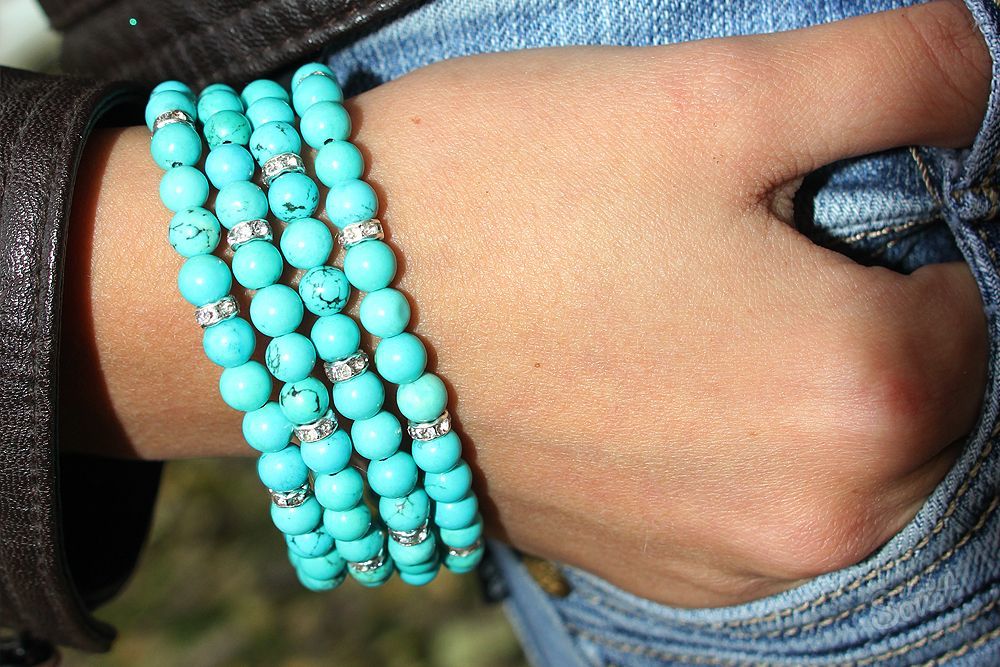
The first fakes of turquoise appeared in ancient Egypt.
Nowadays, imitations made of porcelain, painted glass, plastic, bone, soaked in a solution of copper salts and ceramics with coloring pigments (sometimes natural turquoise chips are used instead of pigments) are given out for it.
Under the guise of turquoise, they often sell cheaper minerals (lapis lazuli, chalcedony, howlite and variscite), which have an external resemblance to it.
In order to determine whether the purchased stone is natural, you can:
- Rub his napkindipped in alcohol. The paint remaining on the hands and napkin is a sign of a fake.
- Weigh stone in the palm of your hand. The lack of gravity is typical for plastic imitation.
- Apply sample to cheek: it must be cold. A natural gem will remain cold for a long time even in the hands.
- Scratch a stone with a needle (this should be done from the wrong side of the product). A scratch should appear on the surface of natural turquoise. Its absence, the appearance of chips, which are removed from the surface of the sample like a serpentine, or the white color of the furrow left by the needle - all these are evidence of a gross fake.
- Pay attention to sample size. Large stones are rare in nature. Most often, their dimensions do not exceed 5 cm.
- Hold the gem over the fire. Turquoise will crack and turn brown, without spreading a pungent odor. A fake will give itself away by the appearance of a repulsive stench.
- Examine the stone through a magnifying glass. The presence of air bubbles is typical for colored glass imitation.
- Think about the price of a stone. If it is below $200, it is most likely an imitation.
What stones are combined with
- Combination with agate
- Combination with jade
- Combination with jasper
Being a stone of the Earth, turquoise goes well with opaque dense minerals that have a similar structure and complement each other energetically:
Fire Gems (precious diamond, tourmaline, ruby, red garnet and zirconium), which can suppress the healing and magical qualities of turquoise, are completely incompatible with it.
Turquoise compatibility and amethyst considered neutral.
Turquoise Care
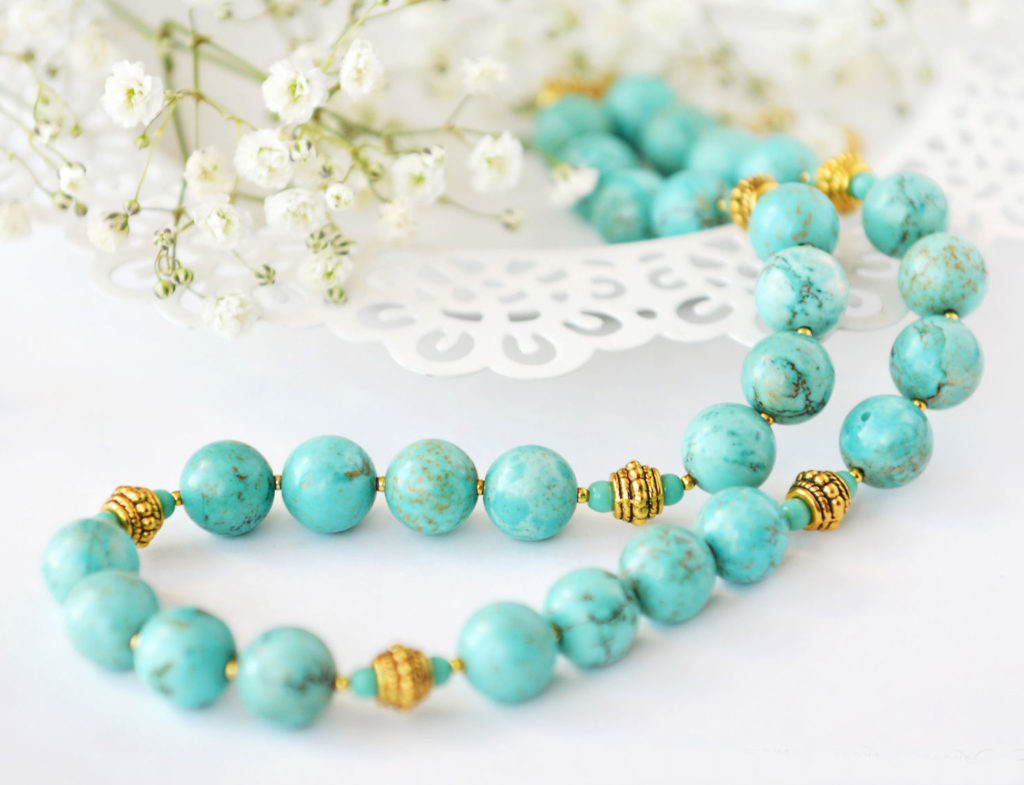
Turquoise, which is one of the sensitive minerals, actively absorbs essential oils, fats and moisture.
Due to the high concentration of carbon dioxide in the air, it can change its color from bright blue to dull green.
With prolonged exposure to the sun, it becomes discolored, and when exposed to high temperatures, it is destroyed.
To preserve the beauty of the stone for many years, you must:
- Take off jewelry with turquoise before visiting the pool, sauna and beach, as well as before doing any household work (washing floors, washing and cooking).
- To not allow contact of the stone with cosmetics (creams, soaps and perfumes).
- To wear pendants and pendants over clothes (otherwise they can absorb dirt, sweat and grease).
- To purify a gem, afraid of water, it is enough to wipe it with a piece of suede or a dry soft cloth (wool or flannel). In case of severe contamination, you can quickly rinse it with distilled water and dry it immediately. Steam and ultrasonic cleaning are not allowed.
- Keep jewelry in a closed box, away from sunlight.
Interesting Facts

- A dream in which turquoise has faded and has lost its original brilliance, should be interpreted as a warning about the appearance of ill-wishers or envious people. In all other cases, the turquoise seen in a dream portends the imminent fulfillment of cherished desires.
- Easterners in ancient times, dull turquoise was “revived” by lubricating it with tail fat or lamb fat. Some, for the same purpose, rubbed it with a piece of raw meat or let it be swallowed by poultry (goose or turkey).
- In Iran turquoise, which is the national stone of this country, is valued more than gold.
- According to popular belief, a turquoise stone can alleviate the condition of a person suffering from a severe hangover. To get rid of a hangover syndrome, healers advise, taking a polished piece of gem with your right hand, massage your left buttock well with it.
